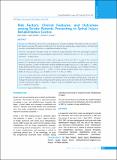Please use this identifier to cite or link to this item:
https://hdl.handle.net/20.500.14356/1161| Title: | Risk Factors, Clinical Features, and Outcomes among Stroke Patients Presenting to Spinal Injury Rehabilitation Centre |
| Authors: | Dhakal, Raju Khadka, Anjita Groves, Christine |
| Citation: | DhakalR., KhadkaA., & GrovesC. (2021). Risk Factors, Clinical Features, and Outcomes among Stroke Patients Presenting to Spinal Injury Rehabilitation Centre. Journal of Nepal Health Research Council, 19(03), 603-607. https://doi.org/10.33314/jnhrc.v19i3.3728 |
| Issue Date: | 2021 |
| Publisher: | Nepal Health Research Council |
| Article Type: | Original Article |
| Keywords: | Nepal rehabilitation stroke |
| Series/Report no.: | July-Sep, 2021;3728 |
| Abstract: | Abstract Background: Worldwide, stroke is the second leading cause of death and disability. The burden of stroke in countries like Nepal is increasing. The purpose of this study is to describe the epidemiology, clinical features, and functional outcomes of individuals with stroke in a rehabilitation hospital in Nepal. Methods: A prospective descriptive study was conducted among individuals with stroke presenting for inpatient rehabilitation to the Nepal’s first interdisciplinary inpatient stroke rehabilitation unit over a one-year period; from 1 April 2018 – 30 March 2019. Results: Twenty-four individuals were enrolled, with average age of 56.8 years (SD 11.9, range 38-79). Seventeen patients (71%) presented with ischemic stroke. Hypertension was the most common modifiable stroke risk factor observed, present in 21 (88%) of individuals. Median rehabilitation length of stay was 32.5 days (IQR 15.3 – 68.8). Median Modified Barthel Index at admission was 25.0 (IQR 8.5-57.0) and at discharge was 67.0 (IQR 46.0-88.0), a statistically significant improvement (Z = -3.408, p = 0.001). Median Modified Rankin Scale on admission was 5.0 (IQR 4.0-5.0) and at discharge was 4.0 (IQR 3.6-4.8; Z = -3.276, p = 0.001). Conclusions: Most individuals with stroke admitted for interdisciplinary stroke rehabilitation demonstrated “severe” levels of disability and dependency on admission, and “moderate” levels of disability and dependency at the time of discharge. Hypertension represents a strategic target for primary and secondary prevention of stroke. With the burden of stroke increasing in Nepal, it is imperative to improve long-term availability and access to comprehensive stroke care for all affected individuals. Keywords: Nepal; rehabilitation; stroke |
| Description: | Original Article |
| URI: | http://103.69.126.140:8080/handle/20.500.14356/1161 |
| ISSN: | Print ISSN: 1727-5482; Online ISSN: 1999-6217 |
| Appears in Collections: | Vol. 19 No. 03 (2021): Vol 19 No 3 Issue 52 Jul-Sep 2021 |
Files in This Item:
| File | Description | Size | Format | |
|---|---|---|---|---|
| 3728-Manuscript-25082-1-10-20211215.pdf | Fulltext Download | 308.05 kB | Adobe PDF |  View/Open |
Items in DSpace are protected by copyright, with all rights reserved, unless otherwise indicated.
